It was only last year when Apple began to wake up to the fact that its users need more storage on the entry-level iPhone or iPad models. Last year’s iPhone model came with 32GB base storage option and this year the company has once again bumped the entry-level model storage to 64GB. However, all those having a 16GB iPhone model are still experiencing lack of free available space. To make things easier for users with older models, Apple has been adding new features in iOS updates to save on-device space. iOS 11 is no different.
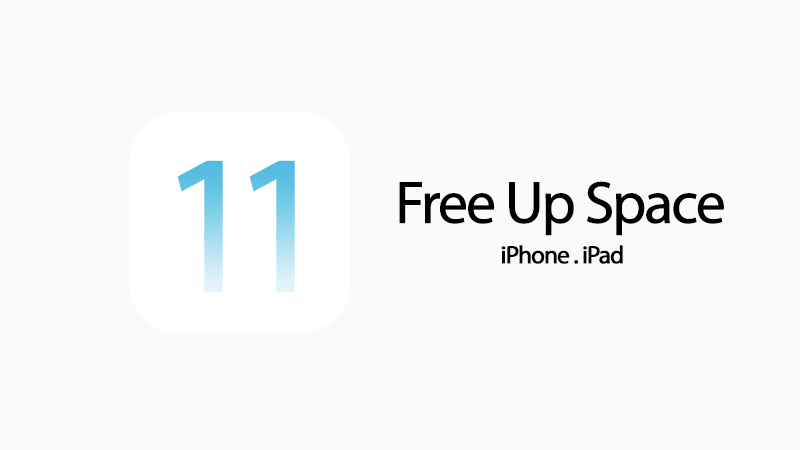
Free Up Space on iPhone or iPad iOS 11
Here are the tips that will help you in reclaiming some storage space on your iPhone or iPad running iOS 11 software update.
Offload Unused Apps
The easiest way to regain free space on iPhone is to look for the apps you hardly use and delete them. You can achieve that by going to Settings > General > iPhone Storage and manually go through all the apps to find the ones taking a lot of space and are hardly in use. However, in iOS 11, Apple has turned this into an automated process. All you need to do is enable the Automatically Offload Apps option under Settings > iTunes & App Stores > Offload Unused Apps to ON position. You can also offload individual app from iPhone/iPad Storage.
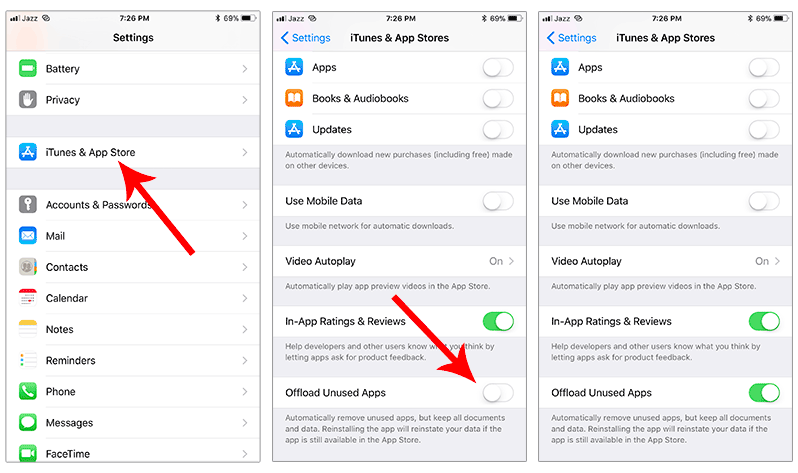
The “Automatically Offload Apps” option in iOS 11 keep track of your frequently used apps and those that you have not used in weeks/months. When your iPhone is running out of storage space, the iOS 11 will automatically remove the apps that have not been in use for a long time. Please note that this will only delete the app itself, not the data or documents associated with it. So upon reinstalling the app, it will have all its data when it was kicked off from your iPhone or the iPad.
Follow Storage Recommendations
iOS 11 comes with new storage recommendations section under iPhone Storage section. This section gives you advice on how to free up space, such as deleting iMessage attachments or deleting an old iTunes movie.
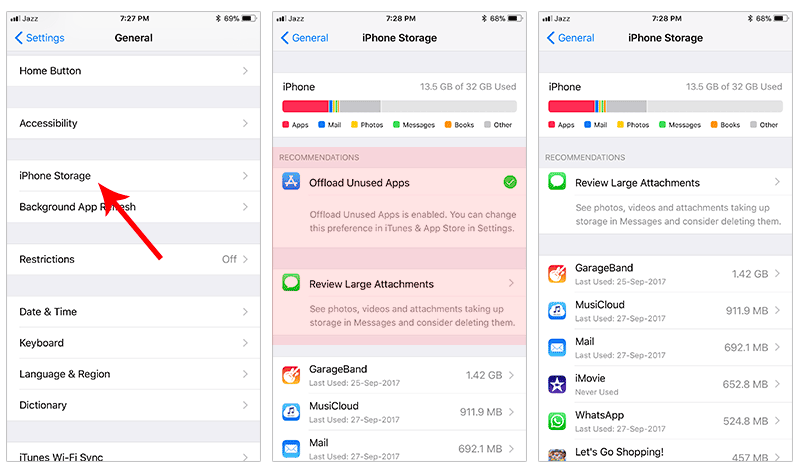
Remove Unwanted Photos and Videos
One of the great photography techniques is to take as many clicks as you can. This increases your chances of capturing an excellent shot with your iPhone camera. But this method also eats much of your iPhone’s storage capacity. The more photos you take, the less free available room you’ll have on your device. The problem starts to grow bigger when you forget to delete photos that were not so great.
If your device is low on storage space, it is high time to go through your Camera Roll and delete the photos you don’t need. Don’t be surprised if you find a few hundred photos, screenshots, and videos worth removing. After doing that you will have a couple of GBs as free storage on your iPhone or the iPad.
Use iCloud Photo Library or Google Photos
Once you’ve deleted all the unwanted photos from your Camera Roll, it’s the best time to back them up to the cloud storage and remove the old photos from the iPhone or iPad. There are two reliable options to backup your photos in the cloud; the iCloud Photo Library and Google Photos.
You can enable iCloud Photo Library from Settings > Photos. Your Apple ID comes with 5GB of free iCloud Library storage. If your pictures are more than 5GB worth of storage, you can upgrade your iCloud plan to 50GB/month by paying $0.99/month (a price worth paying for the peace of mind.) Once all your photos have uploaded to iCloud, you can point iCloud Photo Library to keep only the latest photos on your device. Under Photos section, tap on Optimize iPhone Storage.
Alternatively, you can upload your photos to Google Photos that offers unlimited photo storage for free (with some compression applied). After uploading your photos to Google Photos, you can choose to delete photos from your local storage.
Delete Live Photos Content
When you capture a Live Photo, you are also saving 3-seconds audio and video along with the still photo. While the Live Photos are a fun feature, but for most of the photos it is not useful and takes up a lot of space.
There is an app called “Lean” available in the app store for $1.99. It removed the Live part of the Live Photos but keep the stills. By eliminating the Live part, you can reclaim a couple of GBs of free space from hundreds of Live Photos.
Delete Safari Cache
Go to Settings > Safari and “Clear History and Website Data.” Confirm the popup to delete the entire history, cache data, and cookies related to your visited sites.
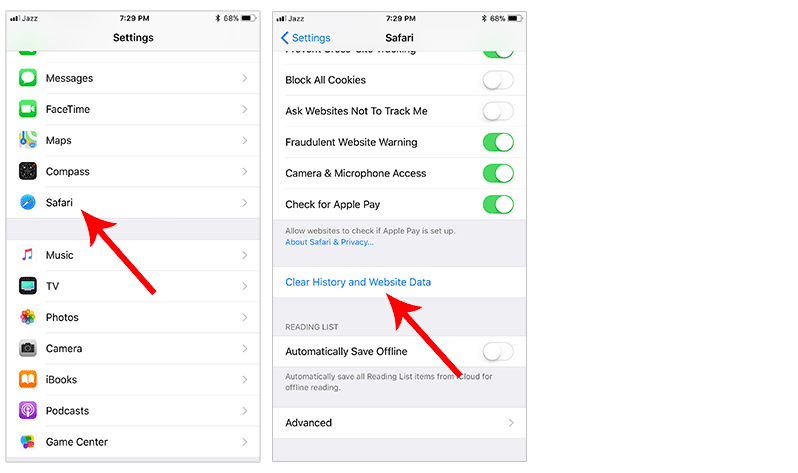
Clear from Recently Deleted Album
When you remove a photo manually, or you’ve removed Live Photos, they go straight to Recently Deleted Album. So make sure to clear the Recently Deleted Album section to get the free space back on your iPhone.
Open Photos app, and go to Albums tab and select Recently Deleted. Select all the photos there and tap on Delete.
Delete Messages Attachments
Open Messages app and delete all the old threads that contain a lot of media. Alternatively, you can go to a particular conversation, tap on the top image and see all the attachments for the thread. Select any attachment and tap Delete to remove it from the device.
Delete Old Messages
If you do not care about your past iMessage conversations, iOS 11 gives you the option to delete old messages automatically. You can turn the automatic deletion of messages by going to Settings > Messages >Â Keep Messages and select 30 days or 1 Year.
Remove Extra Siri Voices
A single Siri voice file can be as much as 900MB in size. So, if you have downloaded more than one Siri voices, it’s time to remove them. Go to Settings > General > Accessibility > VoiceOVer > Speech and choose the language. Tap on Edit and tap red ‘-‘ button to remove the language or simply swipe left to delete.
Getting Rid of Local Media Content
Under Settings > General > iPhone Storage section, you can see all the installed apps along with the space taken by them. For some apps, the documents attached to them will be taking up the more space. Â For instance, movies downloaded from iTunes of Netflix will be sitting on your device. The same happens to audiobooks, podcasts, and related media content.
So all you need to do is manually delete apps data. If the apps like Facebook or Twitter are taking document storage space of 1GB or more, you can only delete the apps to reclaim the storage space taken by their documents. After that, you can reinstall these apps.
Remove iTunes Cache
If you use the iTunes app on your device to buy or rent movies, the app might still have its cache files resting on your device. These cache files are visible to the user and sometimes weighs in GBs. A soft reboot may help you in deleting iTunes cache files. To perform a soft reset, tap and hold the Home + Sleep/Wake button (Vol. down + Sleep/Wake button for iPhone 7) till you see the phone reboot.
Optimize Apple Music Storage
iOS can automatically manage the storage used by Apple Music library.  To enable the optimization feature go to Settings > Music and choose Optimize Storage. You can set the limit between 4GB to 64GB Apple Music Storage depending on the storage capacity of your device. Once your Apple Music has reached the set limit, iOS 11 will automatically delete the Music you’ve not heard to in a while.
Disable Auto Downloading Media in WhatsApp
WhatsApp automatically downloads all the media sent to you in different groups of one-to-one conversations and save it to your camera roll. You can disable the auto-downloading of WhatsApp media content by going to Settings > Chats and turn off Save Incoming Media.
Download a Huge App or Movie
Note: this is a trick/hack that might or might not work for you.
Go to App Store and try to download an app that weighs more than the free available space on your iPhone or iPad. You can try the same by downloading a movie. By doing this, iOS 11 will automatically clean the cache and junk files to make room for the app/movie. After a while, stop the downloading or the app/video. This way you can reclaim some extra free space.
Reset Your Device
Followed all the tips mentioned above? Still running low on free available storage? As a last resort, you should reset your iPhone or iPad. You can reset your iOS device by going to Settings > General > Reset and tap on “Erase All Content and Settings.”
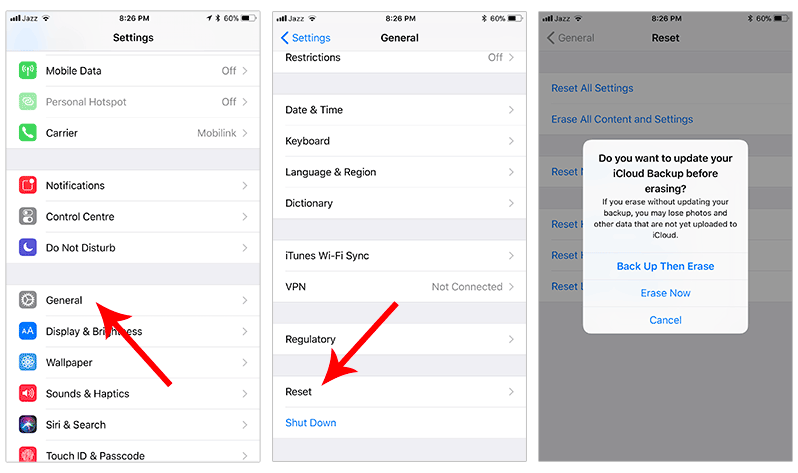
That’s it, readers! Which one was your favorite tip to free up space on your iPhone or iPad running iOS 11? Let us know in the comments section below.
The post How to Free Up Space on iPhone or iPad running iOS 11 appeared first on iPhoneHeat.



